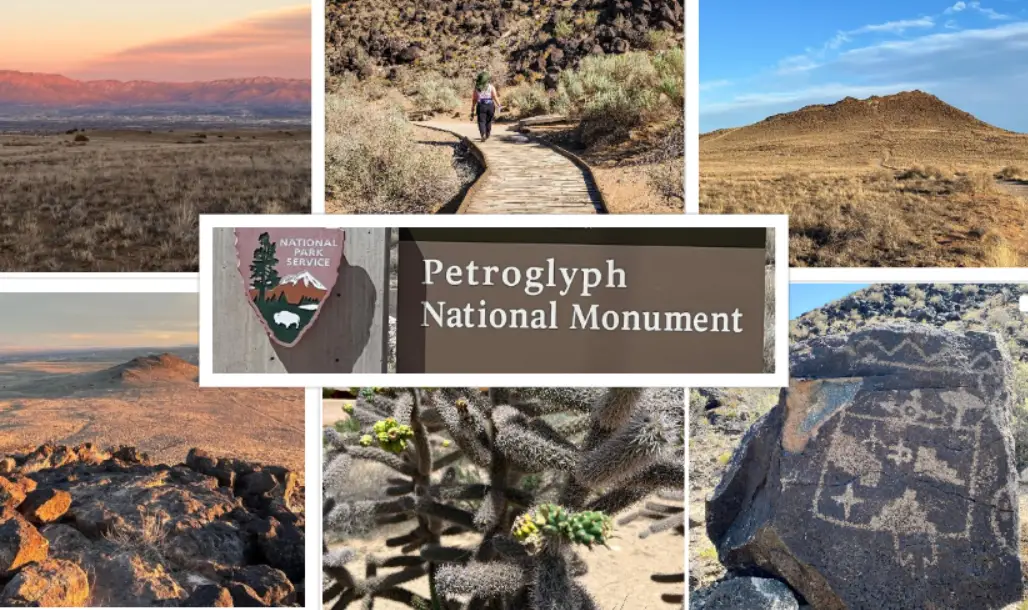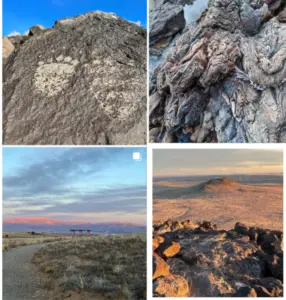Petroglyph National Monument : Interesting Facts, History & Travel Guide

- By
- Aparna Patel
- |
- 13 Apr, 2023
- |

Petroglyph National Monument, located in Albuquerque, New Mexico, is a stunning destination that is filled with incredible history, fascinating geology, and natural beauty. The park is home to one of the largest petroglyph sites in North America, featuring over 25,000 ancient rock carvings that date back to between 1300 and 1600 AD.
The monument also boasts unique volcanic landscapes, hiking trails, and stunning views of the Sandia Mountains.
In this blog post, we’ll dive into the fascinating history and geology of Petroglyph National Monument, provide interesting facts about the site, and offer a comprehensive travel guide to help you plan your visit to this incredible destination. So, let’s explore the wonders of Petroglyph National Monument together!
Table of Contents
Interesting facts about Petroglyph National Monument
- Petroglyph National Monument is located in Albuquerque, New Mexico, and covers an area of 7,244 acres.
- The monument contains one of the largest collections of petroglyphs in North America, with over 25,000 petroglyphs carved by Native Americans and early Spanish settlers.
- The petroglyphs at the monument are believed to be between 400 and 700 years old, and depict a variety of subjects, including animals, humans, and abstract designs.
- The monument is also home to several volcanic cones and lava flows, which formed around 200,000 years ago.
- The park offers several hiking trails, ranging from easy to strenuous, that allow visitors to explore the petroglyphs and volcanic features.
- Petroglyph National Monument was established as a national monument in 1990, after a long campaign by local residents to protect the petroglyphs from development and vandalism.
- The monument is managed by the National Park Service and receives over 200,000 visitors each year.
- The park is also home to a variety of wildlife, including coyotes, bobcats, rattlesnakes, and several species of birds.
- In addition to hiking, visitors can also enjoy rock climbing, horseback riding, and picnicking at the monument.
- Petroglyph National Monument is a sacred site for several Native American tribes, and visitors are asked to treat the petroglyphs with respect and not to touch or deface them in any way.
Petroglyph National Monument characteristics
Petroglyph National Monument is a unique and fascinating destination located in Albuquerque, New Mexico. Here are some of the characteristics that make the monument so special:
- Petroglyphs: The park is home to one of the largest petroglyph sites in North America, with over 25,000 ancient rock carvings that depict animals, humans, and various symbols. These petroglyphs were created by early Puebloan peoples between 1300 and 1600 AD.
- Volcanic landscapes: The monument is also home to several dormant volcanoes, which have created unique and dramatic landscapes that are unlike anything else in the region.
- Wildlife: The park is home to a variety of wildlife, including coyotes, snakes, lizards, and a variety of bird species.
- Hiking trails: The monument offers several hiking trails that allow visitors to explore the petroglyphs and the surrounding landscapes. The trails range in difficulty and length, making them accessible to visitors of all ages and skill levels.
- Cultural significance: The petroglyphs and surrounding landscapes hold great cultural significance to the indigenous Puebloan peoples, who have lived in the region for thousands of years.
Overall, Petroglyph National Monument is a truly unique destination that offers visitors a fascinating glimpse into the ancient history and natural beauty of the Southwest.
Petroglyph National Monument elevation
Petroglyph National Monument’s elevation varies throughout the park. The monument covers a total area of 7,236 acres, and the elevation ranges from about 4,900 feet to 6,500 feet above sea level. The Sandia Mountains, which form the eastern boundary of the monument, have peaks that rise to over 10,000 feet. The varied elevation levels in the park contribute to the unique landscapes and diverse flora and fauna found within the monument.
Petroglyph National Monument limiting factors
Like any natural area, Petroglyph National Monument has some limiting factors that affect the park’s ecosystem and visitor experience. Here are some examples:
- Climate: The park is located in a desert environment and is subject to extreme temperatures, including very hot summers and cold winters. These conditions can limit certain types of plant and animal life, and visitors need to be prepared for the weather conditions during their visit.
- Human impact: Petroglyph National Monument contains a large number of ancient rock carvings, which are highly sensitive to human impact. Visitors are encouraged to stay on designated trails and avoid touching or defacing the petroglyphs in any way.
- Wildlife management: The park is home to a variety of wildlife species, including coyotes, snakes, and lizards. Visitors are advised to exercise caution and keep a safe distance from any wildlife they may encounter.
- Limited facilities: The park’s visitor center and facilities are limited, which can impact the visitor experience. It’s important for visitors to plan ahead and bring all necessary supplies, such as water and sunscreen.
Overall, Petroglyph National Monument is a unique and sensitive natural area that requires careful management to preserve its delicate ecosystems and cultural resources for future generations.
Read More:
- Organ Pipe Cactus National Monument : Interesting Facts, History & Travel Guide
- Organ Mountains–Desert Peaks : Interesting Facts, History & Travel Guide
- Oregon Caves National Monument : Interesting Facts, History & Travel Guide
- Newberry Volcanic Monument : Interesting Facts, History & Travel Guide
- Muir Woods National Monument : Interesting Facts, History & Travel Guide
Information & History of Petroglyph National Monument
Petroglyph National Monument is located on the western edge of Albuquerque, New Mexico. The monument covers over 7,000 acres and contains one of the largest concentrations of petroglyphs in North America. The petroglyphs are images carved into volcanic rocks by Native Americans and early Spanish settlers over 400 to 700 years ago.
The area that is now the monument has been inhabited by Native Americans for thousands of years. The petroglyphs at the site are believed to be the work of several different cultures, including the Ancestral Puebloans, who lived in the region from about AD 400 to 1400, and the Spanish colonizers who arrived in the area in the 1500s.
The first recorded visit to the petroglyphs by Europeans was by a Spanish expedition led by Don Juan de Oñate in 1598. The area continued to be used by Native Americans for religious and cultural purposes throughout the colonial period and into the 19th century.
In the 20th century, the area around the petroglyphs became a popular site for hiking and rock climbing. However, increasing development in the area threatened the petroglyphs with destruction and vandalism. In the 1970s, local residents began to organize to protect the petroglyphs, and in 1989, the area was designated as a national monument.
Today, the monument is managed by the National Park Service and offers several hiking trails that allow visitors to view the petroglyphs and explore the volcanic landscape. The park is also home to a variety of wildlife, including coyotes, bobcats, and several species of birds.
Travel Guide for Petroglyph National Monument
If you’re planning a trip to Petroglyph National Monument, here’s a travel guide to help you make the most of your visit:
- Best time to visit: The best time to visit Petroglyph National Monument is during the spring and fall months when the weather is mild and comfortable. Summers can be hot, and winters can be cold and snowy.
- Getting there: The monument is located just west of Albuquerque, New Mexico. The nearest airport is Albuquerque International Sunport. You can rent a car or take a taxi from the airport to reach the monument.
- Entrance fee: There is no entrance fee to visit Petroglyph National Monument.
- Hiking trails: The park has several hiking trails that range from easy to moderate. The trails offer scenic views of the petroglyphs and the surrounding landscape. The Boca Negra Canyon trail is a popular hike that leads to several petroglyphs and a panoramic view of the city of Albuquerque.
- Visitor center: The visitor center has exhibits on the history and culture of the area, as well as information on the hiking trails and other activities in the park.
- Wildlife viewing: The park is home to several species of wildlife, including coyotes, bobcats, and several species of birds. Keep an eye out for these animals as you explore the park.
- Rock climbing: If you’re an experienced rock climber, you can try climbing the volcanic cliffs in the park. However, climbing is only allowed in designated areas, and you must obtain a permit from the park rangers before climbing.
- Camping: There are no camping facilities in Petroglyph National Monument. The nearest campgrounds are located in nearby national forests.
- Nearby attractions: The city of Albuquerque offers a variety of attractions, including museums, restaurants, and cultural events. The nearby Sandia Mountains also offer hiking and outdoor recreation opportunities.
- Respect the petroglyphs: The petroglyphs at the park are sacred to several Native American tribes. Visitors are asked to respect the petroglyphs and not to touch or deface them in any way.
More Post
- Mount St. Helens Volcanic : Interesting Facts, History & Travel Guide
- Montezuma Castle National Monument : Interesting Facts, History & Travel Guide
- Mojave Trails National Monument : Interesting Facts, History & Travel Guide
- Misty Fjords National Monument : Interesting Facts, History & Travel Guide
Some frequently asked questions about Petroglyph National Monument:
What are petroglyphs?
Petroglyphs are images carved into rock surfaces. The images at Petroglyph National Monument were created by Native Americans and Spanish settlers between 400 and 700 years ago.
How many petroglyphs are in the park?
There are an estimated 25,000 petroglyphs in Petroglyph National Monument.
Are the petroglyphs protected?
Yes, the petroglyphs are protected by the National Park Service, and visitors are asked not to touch or deface them in any way.
Can I climb on the petroglyphs?
No, climbing on the petroglyphs is strictly prohibited.
Are there any guided tours available?
Yes, the park offers guided tours led by rangers and volunteers. Check with the visitor center for more information.
Are pets allowed in the park?
Yes, pets are allowed in the park, but they must be kept on a leash at all times.
Is there an entrance fee?
No, there is no entrance fee to visit Petroglyph National Monument.
What other activities are available in the park?
In addition to hiking and viewing the petroglyphs, the park offers opportunities for birdwatching, rock climbing, and stargazing.
Can I camp in the park?
No, there are no camping facilities in Petroglyph National Monument.
Are there any other national parks or monuments nearby?
Yes, nearby national parks and monuments include Bandelier National Monument, Chaco Culture National Historical Park, and El Malpais National Monument.
Search Posts
Latest posts
-
5 Mar, 2024
How to avoid drinking vodka?
Popular posts
-
5 Mar, 2024
Why prohibit engine braking?
